Madreimov Amed1, Zaydullaeva Mexriban2, Kudiyarov Islam3, Yodgorova Nodira3
1Department of Epidemiology, Karakalpakstan Medical Institute, Nukus, Uzbekistan
2Department of General Hygiene, Karakalpakstan Medical Institute, Nukus, Uzbekistan
3Department of Microbiology, Virology and Immunology, Tashkent Medical Academy, Tashkent, Uzbekistan
Copyright © 2024 The Author(s). Published by Scientific & Academic Publishing.
This work is licensed under the Creative Commons Attribution International License (CC BY).
http://creativecommons.org/licenses/by/4.0/

Abstract
An analysis of the dynamics of the dominant ecological and hygienic environmental factors in 2009-2021 found that the incidence of diarrheal infections in the Republic of Karakalpakstan depends on the bacterial contamination of water in open reservoirs, tap water and well water. The food route of transmission of infection predominated, less often through contact and household transmission. Mostly children under 14 years of age and disorganized children of preschool age fell ill. The unprecedented anti-epidemic measures taken against coronavirus infection, including strict quarantine, had a strong impact on the level of barterial and viral infections, in particular on the incidence of diarrhea in 2020.
Keywords:
Incidence of diarealdiseas, Ways of infection transmission, Bacterial pollution, Water from open reservoirs, Tap water, Well water, Dependence, Correlations
Cite this paper: Madreimov Amed, Zaydullaeva Mexriban, Kudiyarov Islam, Yodgorova Nodira, Diarrheal Diseases During the Covid-19 Pandemic in the Republic of Karakalpakstan, American Journal of Medicine and Medical Sciences, Vol. 4 No. 2, 2024, pp. 287-293. doi: 10.5923/j.ajmms.20241402.26.
1. Introduction
In the Republic of Karakalpakstan the most common infectious diseases are diarrheal diseases (acute intestinal infections and shigellosis), viral hepatitis and tuberculosis.We hypothesize that harmful environmental and hygienic factors, especially the water factor, have a strong effect on the spread of diarrheal diseases (hereinafter referred to as DD). Therefore, the relationship between remote sensing and some harmful environmental factors was studied.In 2001-2004, DD indicators in the Republic of Karakalpakstan were low compared to the average DD indicators in the Republic of Uzbekistan. However, since 2006, the indicators of the Republic of Karakalpakstan began to greatly exceed the indicators of the Republic of Uzbekistan.
2. Material and Methods
The statistical materials of the Ministry of Health of the Republic of Uzbekistan, the State Center for Sanitary and Epidemiological Supervision of the Republic of Karakalpakstan were used. Epidemiological and statistical methods were used. To increase the reliability of the results obtained, the study decaded was conditionally divided into two five-year planes: 2011-2015 and 2016-2020.
3. Result and Discussion
Analysis of incidence rates of diarrheal diseases in the population of the Republic of Karakalpakstan (hereinafter - DD) for 2009-2021. in the context of districts and conventionally designated zones, its dynamics by year (Table 1) showed that the average incidence rate of DD per 100 thousand population for 2016-2021 was 119.1 in the Republic of Uzbekistan, and 192.7 in the Republic of Karakalpakstan, i.e. 61.8% higher than in the Republic of Uzbekistan. In both the Republic of Uzbekistan and the Republic of Karakalpakstan, the dynamics of remote sensing tends to decrease.Table 1. Dynamics of diarrheal disease indicators by zones of the Republic of Karakalpakstan
 |
| |
|
Over the entire study period of 2009-2021, the indicators of diarrhea in the Republic of Karakalpakstan remained high compared to the indicators of diarrhea in the Republic of Uzbekistan.A comparison of remote sensing indicators was made in the context of conventionally designated zones in the Republic of Karakalpakstan.In the Republic of Karakalpakstan itself, remote sensing indicators in districts and conventionally designated zones vary markedly. Thus, the average incidence rate per 100 thousand population over 13 years is 148.9 in the Western zone, 146.0 in the Southern zone, 120.9 in the Northern zone, 211.2 in the Central zone, with the average indicator of the Republic of Karakalpakstan being 177.7.The incidence rate of the population of the Republic of Karakalpakstan DD for 2009-2019 fluctuated between 86.7 (2020) – 210.7 (2010) per 100 thousand population. The highest levels of DD were recorded in Nukus (2010 - 436.5; 2011 - 362.1; 2012 - 338.1; 2013 - 361.0; 2014 - 329.0; 2015 - 352.7; 2021 - 669.8), Nukus (2009 - 377.4; 2010 - 308.5; 2011 - 303.2), Takhyatash (2021 - 311.6), Turtkul (2014 - 339.0; 2017 - 347.2) districts and in the Central zone (2021 – 323.5). If the decrease in the Kungrad and Takhiyatash districts was more than 2 times, then in the Muynak (41%), Kanlykul (36.1%) and Ellikkala (28.3%) districts an increase was noted.During the period studied 2009-2021, the highest levels of diarrhea were observed in the city of Nukus of the Central Zone in 2010 - 436.5 per 100 thousand population, in 2011 - 362.1; in 2012 – 338.1; in 2013 – 361.0; in 2014 – 329; in 2015 - 352.1 and in 2021 - a record 669.8, and in the Nukus district of the same zone - in 2009 - 377.4; in 2010 – 308.5; in 2011 - 303.2 and in Takhiyatash district in 2021 - 301.6.The same high rates were noted in the Turtkul district of the Southern zone in 2014 - 339.0 and in 2017 amounted to 347.2.If in 2016-2020 in the Southern, Central and Southern zones the incidence of diarrhea remained closer to the level of the Republic of Karakalpakstan, in the Northern zone it was relatively low, then in the Central zone in 2021. It exceeded other zones by more than 3 times.In 2019, the incidence rate of DD in the Republic of Karakalpakstan decreased to 137.9. However, in 2020 this figure fell to 86.7, and in 2021 rose to 203.7. The decrease in the incidence of DD in 2020 was due to quarantine-restrictive, anti-epidemic and preventive measures aimed against the COVID-19 pandemic. The measures taken led to a sharp decrease in viral and certain intestinal infections.In 2019, the incidence rate of DD in the Republic of Karakalpakstan decreased to 137.9. However, in 2020 this figure fell to 86.7, and in 2021 rose to 203.7. The decrease in the incidence of DD in 2020 was due to quarantine-restrictive, anti-epidemic and preventive measures aimed against the COVID-19 pandemic. The measures taken led to a sharp decrease in viral and certain intestinal infections.The study of remote sensing dynamics in the Republic of Karakalpakstan by month of 2021 gave the result shown in Fig. 1.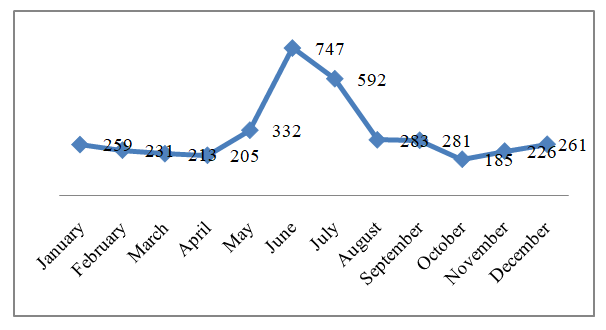 | Figure 1. Seasonality of diarrheal diseases in the Republic of Karakalpakstan by months of 2021 |
We analyzed the age and social composition of people with DD in the Republic of Karakalpakstan for 2021, a year after the start of the COVID-19 pandemic.The number of cases of disease in 2021 was 3944 people, the intensive rate per 100 thousand population was 203.7. The number of children under 14 years old is 3302, which is 83.7%.Intensive incidence rates of DD were: among children under 1 year of age – 375.3; 1-2 years – 665.7; 3-5 years - 241.9; 6-14 years – 140.9; 15-17 years old – 33.9; 18 years and older – 370.3.The socio-professional composition of the disease showed a predominant impact on toddlers. DD indicators among toddlers: among organized children – 399.9; among unorganized – 987.8; among children of kindergarten age: among organized children – 90.9; among unorganized - 147.2, among schoolchildren - 98.7; college and lyceum students – 9.6; among medical workers – 3.4. Children who did not attend child care institutions fell most ill. In 122 cases, children attending preschool institutions (preschool institutions) fell ill; in 20 preschool institutions, 2 sick children were identified, in 4 preschool institutions – 3 children each. This means that group diseases and epidemic outbreaks were not registered.When conducting an epidemiological survey of disease outbreaks, in 3183 (80.7%) cases the routes of transmission of infection were identified: in 154 cases the contact and household route of infection was indicated, in 1975 cases - the food route, in 1035 cases - improper feeding of the child, in 22 cases – waterborne infection from open water reservoirs.When conducting an epidemiological survey of disease outbreaks, in 3183 (80.7%) cases the routes of transmission of infection were identified: in 154 cases the contact and household route of infection was indicated, in 1975 cases - the food route, in 1035 cases - improper feeding of the child, in 22 cases – waterborne infection from open water bodies.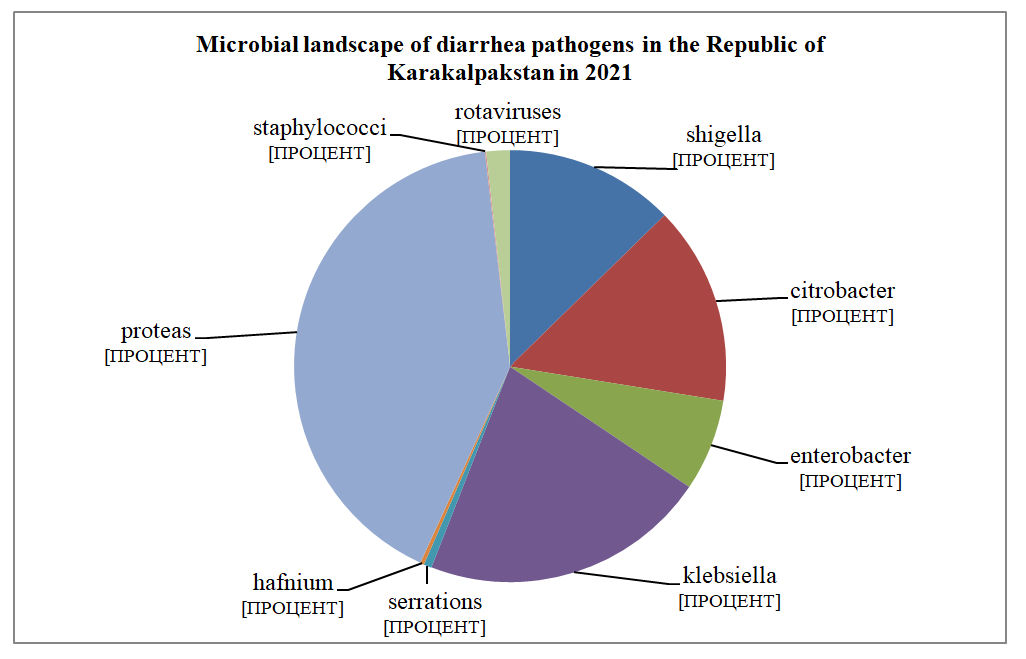 | Figure 2 |
From the examined 3944 patients registered in 2021, pathogens were isolated in 1017 cases, including: Shigella in 129 cases, Citrobacter in 151, Enterobacter in 70, Klebsiella in 219, Serration in 6, Hafnia in 3, in 420 - Proteus, in 1 - staphylococci, in 18 - rotaviruses.In March 2020, COVID-19 was introduced into the Republic of Uzbekistan; the first infected person was identified in the Republic of Karakalpakstan on April 6, 2020.Since the main route of transmission of pathogens of DD was the food route, and less often - contact route of infection, the unprecedented anti-epidemic measures taken against coronavirus infection, including strict quarantine, had a strong impact on the level of intestinal infections, in particular on the incidence of DD.We studied the dynamics of bacterial contamination of water in open reservoirs in regions and zones of the Republic of Karakalpakstan for 2009-2021, to subsequently determine its effect on the incidence of disease. As is known, systematic monitoring of bacterial contamination of drinking water - water from open reservoirs, tap water and well water is not carried out. However, the sanitary and epidemiological service carries out laboratory monitoring of bacterial contamination of water for contamination with E. coli, total microbial counts and pathogenic agents.Table 3 shows the results of studies of bacteriological laboratories of the regional Centers of the State Sanitary and Epidemiological Service, in the form of the percentage of water samples from open reservoirs exceeding the standards specified in the State Standard 950-2011 in force on the territory of the Republic of Uzbekistan and the Sanitary Rules and Standards (SanPiN) of the Republic of Uzbekistan No. 0318-15 “Hygienic and anti-epidemic requirements for the protection of water in reservoirs on the territory of the Republic of Uzbekistan.” We called non-normative samples in which the amount of test substances and indicators (for example, coli index) exceeded the maximum permissible concentrations (MPC) established by SanPiN.The specific gravity or % bacterial contamination of water in open spaces in the Respublic of Karakalpakstan in 2009-2019, that is, before the start of the Covid-19 pandemic, fluctuated between 20.0-33.1%. In 2020-2021 it decreased to 2.8 and 18.7%. This decrease occurred due to stress in the activities of the sanitary and epidemiological service due to the diversion of its forces to fight the new epidemic.We tried to connect the influence of bacterial contamination of water bodies on the incidence of disease, implying that high water contamination with E. coli implies high bacterial and viral contamination, and in case of disease one of the leading routes of infection is the waterway.To establish functional and correlation links between intensive indicators (incidence) of DD and the specific gravity of water samples exceeding those permitted by UzDSt 950-2011 “Drinking Water” for tap water and (SanPiN) RUz No. 0318-15 “Hygienic and anti-epidemic requirements for the protection of water in reservoirs territory of the Republic of Uzbekistan" for the water of open reservoirs, we made calculations using the Pearson method. The reliability of the results obtained was assessed using the Student test.Comparison of dynamics of disease incidence rates for 2009-2021. (Table 2) with indicators of bacterial contamination of water in open reservoirs (Table 3) showed the following results.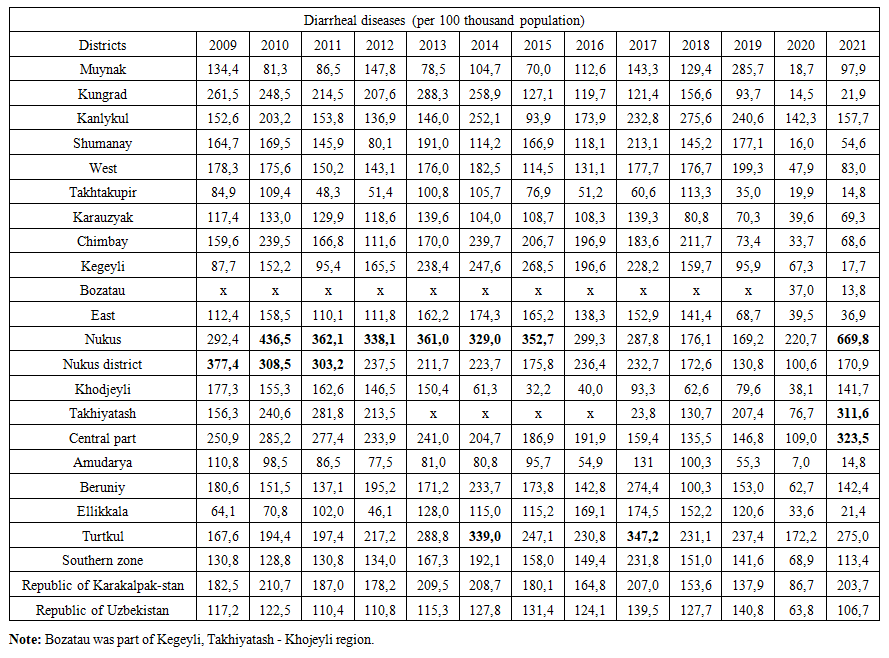 | Table 2 |
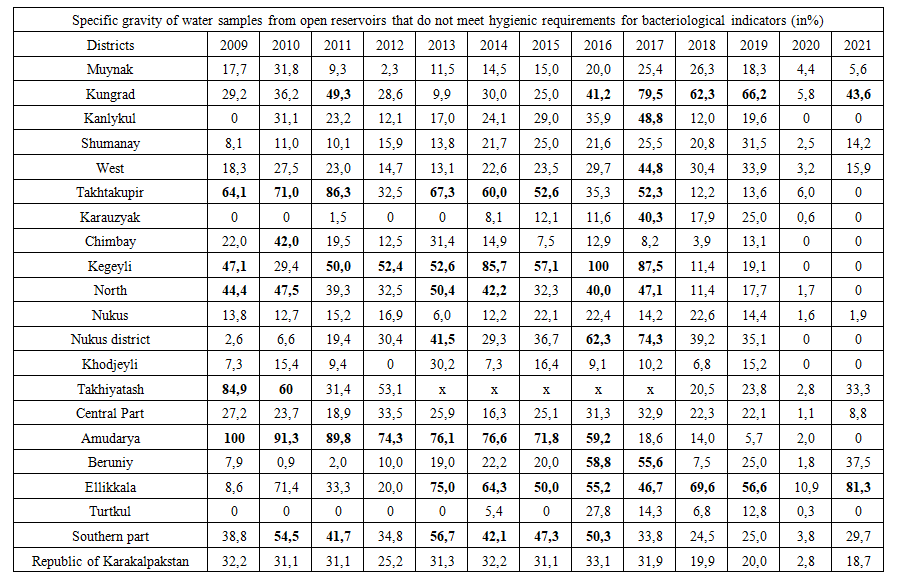 | Table 3 |
In 2009-2021, reliable average direct correlations were identified between the DD indicator and bacterial contamination of open water bodies in the Western zone of the Respublic of Karakalpakstan- Student test indicator rxy = 0.61 (at t = 6.51 and p = 0.95) and in the Shumanay region the same zone - rxy=0.48 (at t=3.84 and p=0.95).The same connection was found in the Chimbay district of the Northern zone - rxy=0.48 (with t=2.30 and p=0.90).In 2009-2021, reliable strong direct correlations were revealed between the DD indicator and bacterial contamination of open water bodies in the Kegeyli district of the Northern zone (rxy = 0.73 at t = 2.19 and p = 0.9) and in the Northern zone itself (rxy =0.786 at t=7.73 and p=0.9).In 2009-2021, reliable average direct correlations were revealed between the RD indicator and bacterial contamination of open water bodies in the Beruniy district of the Southern zone - rxy = 0.48 (at t = 3.84 and p = 0.95) and in the Southern zone itself rxy =0.44 (at t=9.97 and p=0.95).In 2009-2021, reliable strong direct correlations were revealed between the DD indicator and bacterial pollution of open water bodies in the Respublic of Karakalpakstan itself - rxy=0.795 (at t=3.05 and p=0.95).Table 4 shows the results of studies of bacteriological laboratories of the regional Centers of the State Sanitary Epidemiology Service, in the form of the percentage of samples exceeding the standards specified in the State Standard 950-2011 “Drinking Water” in force in the territory of the Republic of Uzbekistan.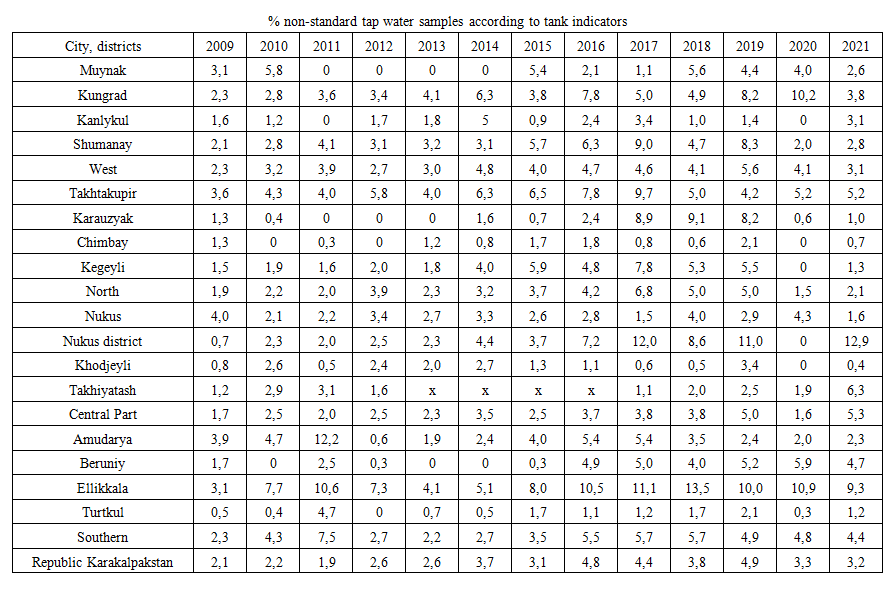 | Table 4 |
In 2009-2021, reliable average direct correlations were revealed between the DD indicator and bacterial contamination of tap water in Kanlykul - rxy=0.43 (with t=7.34 and p=0.95) and Shumanay - rxy=0.43 (at t=1.77 and p=0.8) areas of the Western zone.In 2009-2021, reliable average direct correlations were revealed between the DD indicator and bacterial contamination of tap water in the Kegeyli - rxy = 0.69 (with t = 2.35 and p = 0.95) region of the Northern zone and in the Northern zone itself - rxy=0.33 (at t=6.01 and p=0.95). The same connection was revealed in the Ellikkala district of the Southern zone - rxy=0.41 (with t=6.29 and p=0.95).Table 5 shows the results of studies of bacteriological laboratories of the regional Centers of the State Sanitary and Epidemiological Service, samples of well water, in the form of the percentage of samples exceeding the standards specified in the Sanitary Rules and Standards (SanPiN) of the Republic of Uzbekistan in force on the territory of the Republic of Uzbekistan No. 0318-15 “Hygienic and anti-epidemic requirements for water protection reservoirs on the territory of the Republic of Uzbekistan."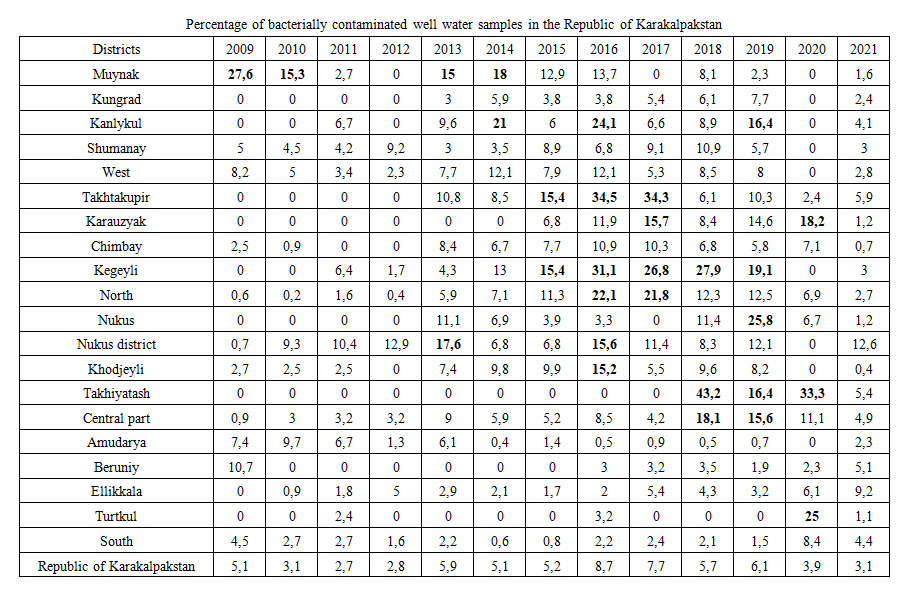 | Table 5 |
In 2009-2021, reliable average direct correlations were revealed between the DD indicator and bacterial contamination of well water in Kanlykul - rxy=0.37 (with t=1.77 and p=0.8) and Shumanay - rxy=0.44 (at t=9.05 and p=0.95) areas of the Western zone and in the Western zone itself - rxy=0.56 (at t=4.39 and p=0.95).The same connection was found in the Kegeyli district - rxy=0.50 (at t=2.40 and p=0.95) district of the Northern zone and in the Amudraya district of the Southern zone - rxy=0.32 (at t=1.57 and p =0.8).
4. Conclusions
1. The incidence rate of diarrhea in the Republic of Karakalpakstan for the period 2009-2022 has a downward trend.2. A sharp decrease in the level of DD in the Republic of Karakalpakstan in 2020 is associated with the implementation of quarantine, restrictive, anti-epidemic and preventive measures against coronavirus infection.3. Disorders mainly affected children under 14 years of age, more than others - unorganized children of preschool age.4. The route of infection was the food route, less often - the contact and household route of transmission of infection. The water route of infection transmission was rarely identified - the infection factor was the water of open reservoirs.5. In 2009-2021, a correlation between the dynamics of remote sensing and bacterial contamination of open water bodies was revealed in the Republic of Karakalpakstan, in the Western zone of the Republic of Karakalpakstan, in the Shumanay district of the same zone, in the Chimbay and Kegeyli districts of the Northern zone, in the Beruniy district of the Southern zone.6. In 2009-2021, a correlation was identified between the DD indicator and bacterial contamination of tap water in the Kanlykul and Shumanay districts of the Western zone, in the Kegeyli district of the Northern zone and in the Northern zone itself, as well as in the Ellikkala district of the Southern zone.7. In 2009-2021, correlations were identified between the DD indicator and bacterial contamination of well water in the Kanlykul and Shumanay districts of the Western zone and in the Western zone itself, in the Kegeyli district of the Northern zone and in the Amudarya district of the Southern zone.The results obtained allow us to conclude that the decrease in the level of disease in the Republic of Karakalpakstanin 2020 is associated with the implementation of quarantine, restrictive, anti-epidemic and preventive measures against coronavirus infection. Disorders mainly affected children under 14 years of age, especially disorganized children of preschool age. The routes of infection were the food route and, much less frequently, contact and household transmission of infection. There were also water transmission routes, namely from open water bodies. Correlations between remote sensitivities and bacterial contamination of water in open reservoirs have been identified in the Republic of Karakalpakstan, in the Northern and Southern zones, tap water in the Western and Northern zones, and well water in the Western, Northern and Southern zones.When planning measures to reduce pollution of environmental objects, you can use the results we obtained, which make it possible to have a differential approach to specific territories of the republic.
References
| [1] | Ataniyazova O.A., Eshchanov T.B., Konstantinova L.G., Kurbanov A.B. The Aral crisis and medical and social problems in Karakalpakstan // Tashkent - 2001. |
| [2] | Atakhanova D.O. Abstract of the PhD dissertation. Hygienic assessment of environmental pollution and its impact on the morbidity levels of the population of the Republic of Karakalpakstan // Tashkent, 2018. |
| [3] | Ilyinsky I.I., Iskandarova G.T., Iskandarova Sh.T. Educational and methodological manual “Scientific and methodological foundations for predicting the incidence of intestinal infections and some non-infectious diseases associated with the water factor.” – Tashkent, 2006. |
| [4] | Madreimov A., Zaidullaeva M.O., Mambetniyazov K. On harmful environmental factors affecting the incidence of children in the Republic of Karakalpakstan. Journal Problems of Biology and Medicine. – Samarkand, 2018. - No. 4-2. – pp. 64-67. |
| [5] | I. Turdimambetov, E. Pauditsova, A. Madreymov, N. Komilova, M. Otewliev, N. Kayupov, K. Utarbaeva, G. Eshimbetova. Influence of harmful Ecological Factors on the Population of the Republic of Karakalpakstan // European Journal of Molekular & Clinical Medicine ISSN 2515-8260 Volume 7, Issue 10, 2020. |
| [6] | Turdimambetov. I., Madreimov. A., Foldvari. L., Utarbaeva. K., Bekanov. K. Influence of Adverse Ecological Factors on the Incidence of Malignant Neoplasms. Scopus Preview E3S Web of Conferences, 2021, 227, 02001 https://doi.org/10.1051/e3sconf/202122702001. |
| [7] | Statistical materials of the Ministry of Health of the Respublic of Karakalpakstan and the Republic of Uzbekistan, the Republican Department of Sanitary-Epidemiological Welfare and Population Health Supervision of the Respublic of Karakalpakstan for 2009-2021. |








 Abstract
Abstract Reference
Reference Full-Text PDF
Full-Text PDF Full-text HTML
Full-text HTML